
HA NOI – Late 19th century works bring Hanoi ancient, harmony with modern beauty.

Hanoi Post Office (75 Dinh Tien Hoang)
The building was formerly known as the Hanoi Post Office and is often called Bo Ho Post Office. This is one of the first public works built by the French in Hanoi. The building was designed by architect Henri Vildieu and built in 1893 – 1899 in neoclassical style. The main side of the building overlooks Dinh Tien Hoang Street, the side is Le Thach Street today.

Hoa Lo Prison (1 Hoa Lo)
Previously, the French name of the prison was Prison Centrale or Prison Center. It was later changed to Maison Centrale (Central House). This is one of the largest prisons of French colonialism in Indochina, preliminarily designed by architect Henri Vildieu from 1895 and built in the years 1896 – 1899. The prison architecture is solid, relatively modern, strictly arranged.
The prison was built in the center of the city overlooking 4 street sides: Rollande Prolonge (Hai Ba Trung), Rue Richaud (Quan Su), Teinturiers (Tho Nhuom) and Prison (Hoa Lo). Today, the work is partly retained to turn to Hoa Lo Street to serve as a historical relic, attracting many domestic and international tourists to visit.

State Bank of Vietnam (49 Ly Thai To)
It used to be the Hanoi branch of the Bank of Indochina (Banque de l’Indochine) established on January 21, 1875 in Paris (France), to issue bills and coins to the colonial lands of France. in Asia. The building is located at the end of Paul Bert garden or current Ly Thai To garden, in front of Hoan Kiem Lake. The Asian decorative motifs used to decorate the building’s facade are the triangular and octagonal patterns that are popular in the architecture of the old Vietnamese temples and pagodas. In addition to the Indochina Bank’s headquarters in Hanoi, the branch in Hai Phong, Ho Chi Minh City also has a unique architecture.

St. Joseph’s Cathedral (40 General Houses)
Hanoi Cathedral inaugurated in 1887, designed in the style of medieval European Gothic architecture, following the model of Notre Dame Cathedral in Paris with wide, curved arches facing the sky. The church is 64.5 m long, 20.5 m wide and two bell towers 31.5 m high with large stone pillars weighing four corners. Up to now, the church is not only the place of worshiping of Catholics but also the destination of many tourists coming to Hanoi.

Government Guest House (12 Ngo Quyen)
This place was formerly the residence of the Governor of Tonkin, built in 1918. The main east side is Henri Rivière Avenue (Ngo Quyen Street), north along Chavassieux Avenue (Le Thach Street). This work was designed by architect Adolphe Bussy in the style of French classical architecture with the influence of the Napoleonic III period. The building has had a long history of anti-French and anti-American history, as well as the imprint of President Ho Chi Minh coming here to work in 1945, under the name of Bắc Bộ Phú.

Trang Tien Plaza (24 Hai Ba Trung)
First built by the French in 1901, this place is called Maison Godard (Godard house). In 1960, the building was renamed Bach Hoa General, owned by the state with items sold by stamps such as fabrics, clothing, accessories, bicycles … In 2002, the work was rebuilt, renamed to Trang Tien Plaza trade center, trading in essentials to luxury products.

Hanoi Opera House (1 Trang Tien)
Previously, the building, called City Theater, was started in 1901. The building was designed by architects Broyer, Harley and François Lagisquet in a neoclassical style, based on the design of the Opéra Garnier Theater ( France).
This is a typical cultural project with aesthetic value, large-scale construction (about 900 seats). Theater at that time was used as a place to perform classical arts such as Opera, chamber music, theater … to serve the elite, the French and a few wealthy Vietnamese. .

Dong Xuan Market (15 Dong Bridge)
The market was built by the French in mid-1889. With a total area of about 6,500 m2, the whole market consists of 5 adjacent houses. The facade has French architecture with 5 triangular parts with holes like a honeycomb, corrugated iron roof.
Dong Xuan Market was the largest concentration of trade in Tonkin at that time. After the fire, in 1995, the Dong Xuan market was rebuilt with an investment of 68 billion VND. Today, the market is built into 3 floors with a total area of nearly 14,000 square meters and about 2,000 business stalls. Follow vnexpress
